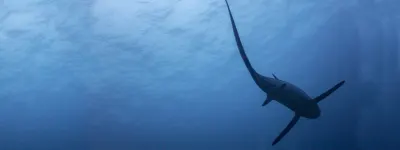As reported in The Guardian, researchers recently uncovered the partial skull of a strange, armoured fish that swam the Earth's oceans over 400 million years ago. And, the details of their discovery could challenge the entire evolutionary history of sharks as we know it!
Bony fish like salmon and tuna – and almost all land animals, from birds to humans – have internal skeletons made of bone. But, the frames of sharks are different. Their internal structures are made of a flexible material called cartilage. This is true of all known species and at all stages of life - from juvenile to adult.

In the past, scientists explained this difference by suggesting that the last common ancestor between sharks and other jawed animals had an internal skeleton made of cartilage. Species with bony skeletons only began to emerge once sharks had already continued down their own evolutionary path, allowing sharks to keep their original cartilaginous frame. These evolutionary steps are considered to be so crucial that all living vertebrates are divided into two categories - "bony vertebrates" and "cartilaginous vertebrates".
Other evidence to support this theory includes the fossilised remains of early shark ancestors called placoderms. These creatures had bony armoured plates that formed part of their jaws, as well as internal skeletons made out of cartilage. But, the recent discovery of a partial placoderm skull made entirely of bone has upended previous theories, leaving some scientists baffled!
This new discovery casts doubt on the idea that sharks branched off the evolutionary tree of jawed vertebrates before bony internal skeletons evolved. And, it's no small discrepancy in the timeline. The discovery of a bony internal skeleton this far back in the history of jawed vertebrates suggests a significant gap in our knowledge of how and when these different groups evolved.
One possible explanation is that bony species could have evolved twice. The first change could have given rise to the newly discovered placoderm and similar still-unknown species. Then, a second development made way for early ancestors of all the planet's other living bony vertebrates. But, a more likely possibility is that a common ancestor of sharks and bony vertebrates actually had a skeleton made from bone, not cartilage. But, at some point along their evolutionary line, sharks specifically lost the ability to make bone.
These findings also lend credibility to the idea that the last common ancestor between modern jawed vertebrates and sharks wasn't some kind of strange hybrid species. In fact, it more likely resembled a placoderm - or primitive bony fish.
While evolutionary biologists have long assumed that the simplest explanation was most likely to be correct, we are now seeing that these evolutionary changes were much more complex than previously assumed. Simply put, this discovery could indicate a bony ancestor shared by sharks and other vertebrates, adding an extra evolutionary step in the incredible history of sharks.




